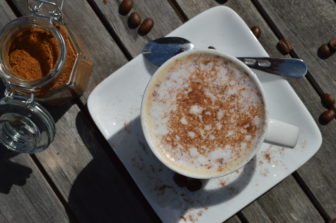“A certain flavor, once relatively rare, has recently become an autumn favorite. It’s simply a blend of nutmeg, ginger, cinnamon and allspice and has been recognized in American cooking for more than a hundred years. It gained popularity in 2003, when Starbucks released one of its most famous drinks: pumpkin spice.
Pumpkin spice’s popularity is partly due to its connection to fall. Freshman Stefan Veizades says, “I feel like pumpkin just has flavors of all of fall in one little recipe. It’s wonderful.”
Because pumpkin is a harvest season icon, the spice mix seems to fit perfectly into autumn. Sophomore Kelsey Dobbs says, “I think of fall because pumpkin spice relates to October, and around that time a lot of people use it in cooking, so you think of Halloween and Thanksgiving.”

For many, the appeal of pumpkin spice is less about its flavor and more about the feelings it elicits. As senior Marly Miller explains,“It’s not cinnamon-y, [yet] it’s this warm tasting thing, but it’s also refreshing. I don’t know, it’s just very nostalgic.” Freshman Sean Parkis adds, “It brings back memories of when I was younger and having good quality family time.”
The seasonality of pumpkin spice also factors into the desirability of the coveted flavor. Junior Brandon Leong says “I feel that, by it being seasonal, more people want it because it’s only sold for a certain period of time. ”
Without this seasonality, pumpkin spice’s fame could quickly dwindle. Leong explains, “[If they] make it a regular flavor, then people are just going to be tired of it.”
Despite its popularity, some students disliked its previous artificial flavor, which Starbucks, has claimed to have replaced with natural pumpkin for this season. Sophomore Talar Arzoumanian says, “ It’s artificially flavored, so I think it would be better if it was actual pumpkin spice.”
Others dislike the drink because of its ubiquity. Sophomore Kathleen Fitzgerald adds, “It’s a good flavor, but I think that it has been blown out of proportion.”
Aside from its taste, pumpkin spice has garnered attention as a part of what is known as the “white girl” stereotype. It centers on a typical association of Caucasian females with yoga pants and pumpkin spice lattes.
Even though she finds the pumpkin spice craze to be overdone, Fitzgerald also finds the ridicule directed against its fans to be unfair: “When you drink pumpkin spice lattes, it’s seen as the typical, common ‘white girl’ drink, but I think people drink it because they actually like the taste.”
Miller adds, “[People] make fun of ‘white girls,’ so it’s become the drink to make fun of.”
Even with the amount of pumpkin spice products that are available in stores and restaurants, the public’s desire for pumpkin spice has yet to be satiated. In fact, according to Google Trends, 2015 is shaping up to be the biggest year for pumpkin spice yet. Pumpkin spice’s popularity makes it clear that when it comes to having what it takes to be the newest food craze, the odds have ever been in its flavor.”



